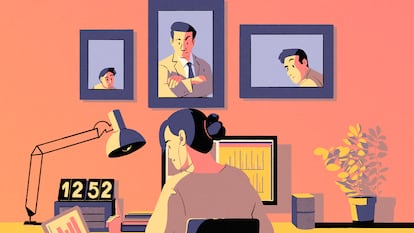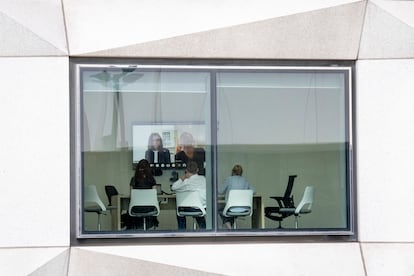Working from home opens the door to ‘productivity paranoia’
In the wake of the pandemic, widespread distrust has plagued the virtual and hybrid work environment, with bosses worried about being cheated, and workers cheating to avoid surveillance

José L.: Good morning
Clara D.: Good morning
… And so on, until the 36th person types “Good morning,” and the work day can begin. It’s nine in the morning, and Alexia D., a graphic designer, types the final “Good morning.” No one dares skip the greeting. Not Alexia, not anyone. If she does, the team leader will log her as absent, even if 10 minutes later she is on the screen with her work completed and a smile on her face, ready to review project updates. “Good morning” is not a polite convention — it is the new time card. After the meeting, Alexia’s main occupation is to never stop moving her mouse. If she does, she will again be logged absent, this time by Slack (an internal messaging system for professional environments), and her boss will immediately shoot her an email: “Everything okay, Alexia?”
Alexia has tried it all. She’s even installed an automated motor on her mouse — a device that simulates constant cursor movements to trick Slack into reporting her status as active. This is how she avoids constant messages from her boss. Alexia works from home in Madrid, Spain, and says she’s convinced that her computer has been infected with “bossware” — spy programs that surreptitiously surveil and measure an employee’s work performance. Is Alexia the laziest worker in the virtual office? She knows she’s not. But even though she meets most of her goals, she fails to stand out as a star in the virtual theater of productivity. She doesn’t perform workplace rituals with the charisma and grace her boss expectation of a person truly “committed to the company family.” So every so often, her overseer needs to check her performance vitals as if she were a terminally ill patient, or a recently captured escaped servant, or simply put, what she is: a worker under constant suspicion and surveillance.
According to The Economist, 2023 will be the year of “productivity paranoia” — one of two dozen “items of vital vocabulary you’ll need to know in 2023″ — with employees paranoid of being watched (they often are: a recent Microsoft survey reported that 9 out of 10 large U.S. companies have installed employee surveillance software) and bosses paranoid that their work-from-home subordinates are doing everything they can to do as little as possible. It doesn’t matter what their productivity reports say: paranoia is a perception, a feeling. It doesn’t need to correspond to reality.

For its fall 2022 survey, Microsoft interviewed 20,000 workers in 11 countries: 87% thought they worked just as efficiently from home as they had from the office. But when Microsoft asked the managers, only 12% believed their teams were more productive when working remotely.
When the Covid-19 pandemic imposed remote work on companies around the world, many bosses had to ditch their old visual practices for measuring productivity — a stroll between cubicles to glance at computer screens, say — for compulsive e-mailing and constant video calls with no purpose other than to keep tabs on their team.
This disconnect between the perceptions of managers and the perceptions of their subordinate workers is precisely what gave rise to the concept of productivity paranoia. Even though more work is being done now than ever before — Microsoft data shows that weekly meetings have increased 153% since 2020, and that multitasking and long hours are the new norm — there is a growing sense that only employees who are under constant surveillance can be considered truly productive.
“Essentially, bosses trust workers who are right there, in front of them. Trust is the result of social relationships. We trust those who we know, or those who look like us, physically or socially,” explains Ayelet Fishbach, a professor of Behavioral Science and Marketing at the University of Chicago’s Booth School of Business. “Technology has attempted to change that by allowing us to connect with people who don’t share our same physical space, but it’s a big hurdle, because our brains aren’t wired to trust people who are far away.”
In a report published in the Harvard Business Review, “Where Managers and Employees Disagree About Remote Work,” a team of academics led by Nicholas Bloom, Professor of Economics at Stanford University, found that the key to this disparity centers around commuting: employees calculated the time and expense of commuting into their productivity, and managers did not. This finding is corroborated by José María Barrero, a professor at Mexico’s Autonomous Institute of Technology and one of the co-authors of the study: “When we ask employees why they feel more productive working from home, the main reason is that they save time and money not commuting to and from work. It’s hard for their managers to see that gain; instead, they’re frustrated that they don’t have the employee in front of them all day,” Barrero explained via email.
To alleviate productivity paranoia, some companies have decided to monitor the minute-by-minute activity of their workers, using bossware that registers mouse movements, keystrokes, screen activity, and even tracks bathroom and coffee breaks. A report by the European Foundation for the Improvement of Living and Working Conditions (Eurofund), Employee monitoring and surveillance: The challenges of digitalisation, estimates that some 40% of Spanish companies have installed algorithmic software to monitor employee activity. This figure was calculated using data provided by the companies using the software, along with data showing increased sales documented by companies that sell it. “Spain is the top European company in the algorithmic monitoring of work activity, ahead of Germany (15%), France (25%), and the United Kingdom (26%),” says José Varela, head of digitization for the UGT, a major Spanish trade union. “It’s curious, because in other areas of digitization, Spain is not in the top tier of EU-27 countries.”
Varela says that in Spain, workers have the right to know if they are being monitored. “In addition, with the ‘Rider Law,’ [a law protecting food delivery workers] in force since 2021, companies have the obligation to inform workers’ councils of the algorithms being used to manage the workplace.”
“If a company decides to implement surveillance software, it needs to be aware of the consequences,” says Fishbach, the University of Chicago professor. “It’s an action that alters the social contract with employees, sends a clear message that the team is no longer considered trustworthy, and then these feelings become reciprocal.”
The employees we spoke with for this report — workers who have been subjected to constant digital monitoring, and who prefer not to identify themselves (including Alexia, which is a pseudonym) — say they find the practice “demoralizing and toxic.” Even the developers who make the software point out that the data are erroneous because they do not measure productivity results, only computer activity. “Measuring productivity with mouse movements is like using a sundial as a stopwatch,” writes Jared Spataro, Microsoft’s Corporate Vice President of Modern Work and Business Applications, in an editorial for Fortune. “And surveillance doesn’t just lead to bad data — it undermines trust, a critical factor in organizational success that, once lost, is incredibly difficult to regain.”
In his many conversations with managers, Varela, the union leader, says that every time he asks what worries them the most about hybrid and remote work, the answer is always the same: productivity. “So I press them: ‘But how can you ensure productivity in a face-to-face work environment?’ And in the end, they admit that there’s really no way. People are confusing face-to-face control with productivity metrics,” he says. Microsoft VP Spataro recommends that managers, large and small, should act more like scientists: “focus on outcomes, measure what matters, and listen to understand,” he writes.
Employees defend themselves against surveillance with devices that simulate the movement of a mouse, making them appear constantly active in programs like Slack. On YouTube, tutorials for installing these devices have thousands of views, and on TikTok, the hashtags #mousejiggler and #mousemover have over one million views. In 2022, the top-rated device on Amazon in 2022 was the Liberty Mouse Mover, a high-end version of the many mouse movers available that promises to be “undetectable.” Free downloads of AutoClicker, a software that moves the cursor following different patterns and clicks the screen every few seconds, have also increased (the search term returns over nine million results on Google).
The Economist describes another consequence of this paranoia: the theater of productivity, or the exaggeration of rituals associated with absolute availability and efficiency. In the face-to-face work environment, these theatrics involve gestures of servility; in the virtual workplace, they involve frequent status updates on Slack, or compulsive emailing.
Productivity paranoia is not just a haze of feelings and fixed ideas with no consequences. The forced return to the office represents the condition’s full material manifestation. “There is a mass return to the office taking place,” Varela says. “Spain was the country in Europe most eager to get back to the office in 2022. In our opinion, it was an overreaction, a consequence of the strong culture of face-to-face work prevalent among Spanish companies.”
Before the pandemic, remote work was a novelty in Spain. According to data from the 2018 Spanish Labor Force Survey, 95.3% of salaried employees had never worked from home. And a report from the human resources company Adecco had warned that more than half of managers disapproved of the idea of remote work. When asked if they would continue to encourage remote work once the pandemic was over, 51.7% of managers said no, and when asked why, the option selected by one in four companies was: “Don’t know / no answer.”

The experts consulted for this story see the benefits and drawbacks of both work models. “In-person collaboration and discussion are very valuable, so working remotely all the time is not an ideal situation either,” explains Barrero. “Going to the office two or three days a week, and then staying home the rest, might sound convenient, but it requires a lot of coordination.” Even Professor Bloom, an outspoken advocate of hybrid work, finds that the weak point of the model is scheduling: “Differences in opinion reflect the need for more clear-cut policies on working from home. The best available approach for most companies is organized hybrid. Employers should choose two or three ‘anchor’ days a week that all employees come into the office,” he writes.
Bloom studied the hybrid work model closely before promoting it is the best of both worlds. According to the calculations of his team at WFH Research (Work from Home Research), which includes researchers from Stanford University, the University of Chicago and MIT, among others, hybrid work would increase productivity by 10% and 20% when compared to the traditional office model. By working two days from home, an employee would save an average of 70 minutes a day by not having to commute, and the company would gain one more hour of work per day, per person. Add to that the fact that in surveys, employees say they get more work done at home, where there is less chance to socialize than at the office. “I have some extremely high-accuracy data on minute-by-minute activity and you can see people at home just take less breaks, less coffee breaks. They go to the toilet less. They’re quicker. They take way shorter lunches. If you’re working from home, your lunch break is typically 20, 30 minutes. If you’re in the office it can easily be over an hour. So those two add up to about 3%, 4% Benefit,” he explained in an interview with Charter.
Bloom’s calculations are in line with research from Gartner, a human resources consultant, which reports that when employees are allowed to decide when and where they work, they are more than twice as likely to increase productivity. “Autonomy is a fundamental human need that significantly reduces worker fatigue and doubles the likelihood of retaining talent,” says Caitlin Duffy, the company’s director.
After two and a half years of remote or hybrid work, there is an alarming lack of trust. “Perhaps managers need to reframe their productivity metrics to adapt to a world with less visibility, where trust has to grow,” Fishbach says. In her research, she found that time is by far the most common productivity metric, because it’s so simple and easy to measure. “It’s much easier to count hours spent in an office than it is to gauge the value of a good idea.”
Sign up for our weekly newsletter to get more English-language news coverage from EL PAÍS USA Edition
Tu suscripción se está usando en otro dispositivo
¿Quieres añadir otro usuario a tu suscripción?
Si continúas leyendo en este dispositivo, no se podrá leer en el otro.
FlechaTu suscripción se está usando en otro dispositivo y solo puedes acceder a EL PAÍS desde un dispositivo a la vez.
Si quieres compartir tu cuenta, cambia tu suscripción a la modalidad Premium, así podrás añadir otro usuario. Cada uno accederá con su propia cuenta de email, lo que os permitirá personalizar vuestra experiencia en EL PAÍS.
¿Tienes una suscripción de empresa? Accede aquí para contratar más cuentas.
En el caso de no saber quién está usando tu cuenta, te recomendamos cambiar tu contraseña aquí.
Si decides continuar compartiendo tu cuenta, este mensaje se mostrará en tu dispositivo y en el de la otra persona que está usando tu cuenta de forma indefinida, afectando a tu experiencia de lectura. Puedes consultar aquí los términos y condiciones de la suscripción digital.
Últimas noticias
The secrets of the Washingtonia palm, named after the first US president
The struggle for hegemony: US and China compete for supremacy in a turbulent landscape
Gary Stevenson: ‘The left has a problem when it comes to how it perceives young men’
Meg O’Neill, the woman who made history in the petroleum industry
Most viewed
- David King, chemist: ‘There are scientists studying how to cool the planet; nobody should stop these experiments from happening’
- Mexico completes its trade shift with the entry into force of tariffs on China and countries without trade agreements
- Reinhard Genzel, Nobel laureate in physics: ‘One-minute videos will never give you the truth’
- Oona Chaplin: ‘I told James Cameron that I was living in a treehouse and starting a permaculture project with a friend’
- Sinaloa Cartel war is taking its toll on Los Chapitos









































